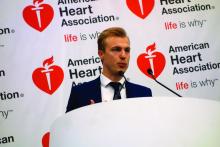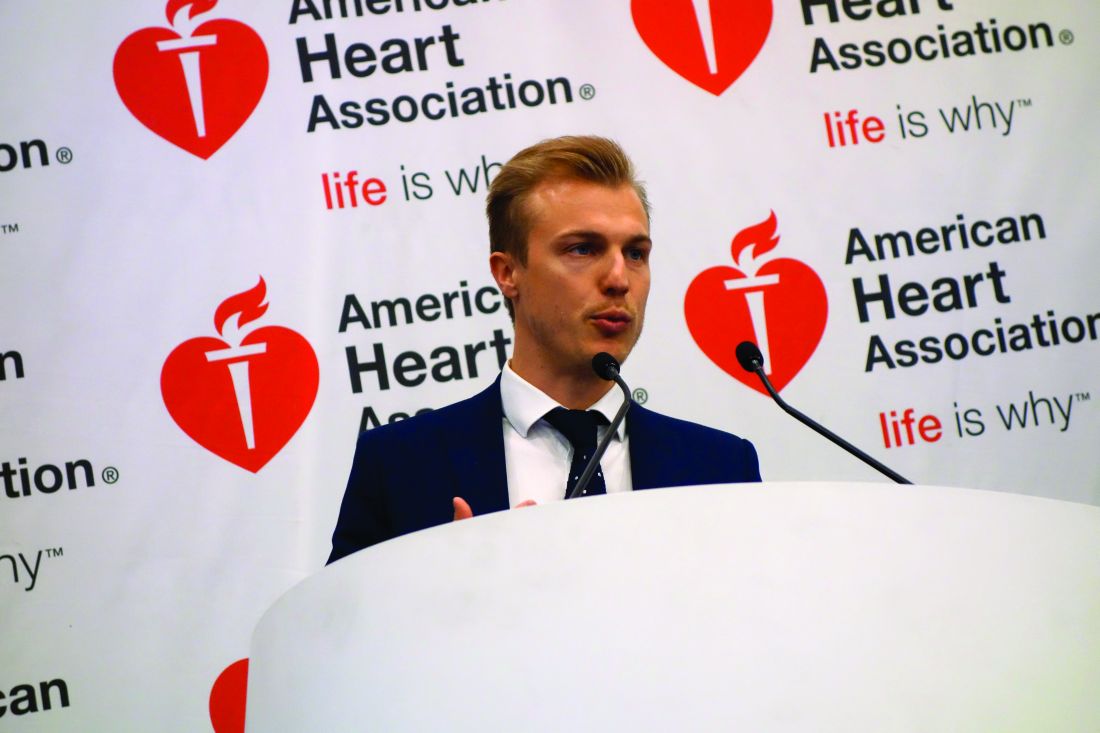User login
ANAHEIM, CALIF. – Children and young adults with type 1 or type 2 diabetes have a 7.4-fold increased risk of sudden cardiac death, compared with nondiabetic, age-matched controls, according to a first-of-its-kind Danish national study.
“Luckily the absolute risk is low, but we hope these data will make [young patients with diabetes] think more about taking their insulin and following their physicians’ recommendations about treatment,” Jesper Svane said in presenting the study findings at the American Heart Association scientific sessions.
Sudden cardiac death (SCD) was the No. 1 cause of mortality in the diabetic cohort with a rate of 34.8 deaths/100,000 person-years, compared with 4.7 deaths/100,000 person-years in an age-matched nondiabetic cohort. That translates to a 7.4-fold increased risk of SCD in the diabetic cohort, noted Mr. Svane, a medical student at Copenhagen University.
When deaths caused by SCD were combined with those from other cardiac diseases, the young diabetic cohort had a rate of 68.3 deaths/100,000 person-years versus 8.2 deaths/100,000 person-years in age-matched controls, for an 8.3-fold increased risk. This observation underscores an important point: Monitoring cardiovascular risk needs to start early in young patients with diabetes.
“It’s important to pay attention when a young person with diabetes comes in complaining of chest pain or syncope,” Mr. Svane said.
The second and third most common causes of death in young Danish diabetic patients were pulmonary and endocrine diseases, which occurred at rates 7.2- and 79.2-fold greater in these patients, respectively, than in controls.
All-cause mortality occurred at a rate of 234.9 deaths/100,000 person-years in young patients with diabetes versus 50.9 deaths/100,000 person-years in matched controls, for a 4.6-fold increased risk.
Autopsies showed that the most common cause of death in diabetic persons aged 36-49 years was coronary artery disease, while in those up to age 35, it was sudden arrhythmic death syndrome, a label bestowed when a medical examiner can’t find an apparent cause of death.
Session moderator Robert H. Eckle, MD, a past AHA president, cautioned against routinely attributing the deaths without apparent cause at autopsy in young people with diabetes to sudden arrhythmic death syndrome. Given that the Danish registry data don’t include data on diabetic patients’ degree of metabolic control, it seems likely that an uncertain number of those deaths were really caused by hypoglycemia, observed Dr. Eckle, professor of medicine at the University of Colorado at Denver, Aurora.
Mr. Svane reported having no financial conflicts of interest.
SOURCE: Svane J. 2017 AHA Sessions.
ANAHEIM, CALIF. – Children and young adults with type 1 or type 2 diabetes have a 7.4-fold increased risk of sudden cardiac death, compared with nondiabetic, age-matched controls, according to a first-of-its-kind Danish national study.
“Luckily the absolute risk is low, but we hope these data will make [young patients with diabetes] think more about taking their insulin and following their physicians’ recommendations about treatment,” Jesper Svane said in presenting the study findings at the American Heart Association scientific sessions.
Sudden cardiac death (SCD) was the No. 1 cause of mortality in the diabetic cohort with a rate of 34.8 deaths/100,000 person-years, compared with 4.7 deaths/100,000 person-years in an age-matched nondiabetic cohort. That translates to a 7.4-fold increased risk of SCD in the diabetic cohort, noted Mr. Svane, a medical student at Copenhagen University.
When deaths caused by SCD were combined with those from other cardiac diseases, the young diabetic cohort had a rate of 68.3 deaths/100,000 person-years versus 8.2 deaths/100,000 person-years in age-matched controls, for an 8.3-fold increased risk. This observation underscores an important point: Monitoring cardiovascular risk needs to start early in young patients with diabetes.
“It’s important to pay attention when a young person with diabetes comes in complaining of chest pain or syncope,” Mr. Svane said.
The second and third most common causes of death in young Danish diabetic patients were pulmonary and endocrine diseases, which occurred at rates 7.2- and 79.2-fold greater in these patients, respectively, than in controls.
All-cause mortality occurred at a rate of 234.9 deaths/100,000 person-years in young patients with diabetes versus 50.9 deaths/100,000 person-years in matched controls, for a 4.6-fold increased risk.
Autopsies showed that the most common cause of death in diabetic persons aged 36-49 years was coronary artery disease, while in those up to age 35, it was sudden arrhythmic death syndrome, a label bestowed when a medical examiner can’t find an apparent cause of death.
Session moderator Robert H. Eckle, MD, a past AHA president, cautioned against routinely attributing the deaths without apparent cause at autopsy in young people with diabetes to sudden arrhythmic death syndrome. Given that the Danish registry data don’t include data on diabetic patients’ degree of metabolic control, it seems likely that an uncertain number of those deaths were really caused by hypoglycemia, observed Dr. Eckle, professor of medicine at the University of Colorado at Denver, Aurora.
Mr. Svane reported having no financial conflicts of interest.
SOURCE: Svane J. 2017 AHA Sessions.
ANAHEIM, CALIF. – Children and young adults with type 1 or type 2 diabetes have a 7.4-fold increased risk of sudden cardiac death, compared with nondiabetic, age-matched controls, according to a first-of-its-kind Danish national study.
“Luckily the absolute risk is low, but we hope these data will make [young patients with diabetes] think more about taking their insulin and following their physicians’ recommendations about treatment,” Jesper Svane said in presenting the study findings at the American Heart Association scientific sessions.
Sudden cardiac death (SCD) was the No. 1 cause of mortality in the diabetic cohort with a rate of 34.8 deaths/100,000 person-years, compared with 4.7 deaths/100,000 person-years in an age-matched nondiabetic cohort. That translates to a 7.4-fold increased risk of SCD in the diabetic cohort, noted Mr. Svane, a medical student at Copenhagen University.
When deaths caused by SCD were combined with those from other cardiac diseases, the young diabetic cohort had a rate of 68.3 deaths/100,000 person-years versus 8.2 deaths/100,000 person-years in age-matched controls, for an 8.3-fold increased risk. This observation underscores an important point: Monitoring cardiovascular risk needs to start early in young patients with diabetes.
“It’s important to pay attention when a young person with diabetes comes in complaining of chest pain or syncope,” Mr. Svane said.
The second and third most common causes of death in young Danish diabetic patients were pulmonary and endocrine diseases, which occurred at rates 7.2- and 79.2-fold greater in these patients, respectively, than in controls.
All-cause mortality occurred at a rate of 234.9 deaths/100,000 person-years in young patients with diabetes versus 50.9 deaths/100,000 person-years in matched controls, for a 4.6-fold increased risk.
Autopsies showed that the most common cause of death in diabetic persons aged 36-49 years was coronary artery disease, while in those up to age 35, it was sudden arrhythmic death syndrome, a label bestowed when a medical examiner can’t find an apparent cause of death.
Session moderator Robert H. Eckle, MD, a past AHA president, cautioned against routinely attributing the deaths without apparent cause at autopsy in young people with diabetes to sudden arrhythmic death syndrome. Given that the Danish registry data don’t include data on diabetic patients’ degree of metabolic control, it seems likely that an uncertain number of those deaths were really caused by hypoglycemia, observed Dr. Eckle, professor of medicine at the University of Colorado at Denver, Aurora.
Mr. Svane reported having no financial conflicts of interest.
SOURCE: Svane J. 2017 AHA Sessions.
REPORTING FROM THE AHA SCIENTIFIC SESSIONS
Key clinical point: Young persons with diabetes are 8.3-fold more likely to die of cardiac causes.
Major finding: In particular, the risk of sudden cardiac death in Danish children and young adults with diabetes was 7.4-fold greater than in age-matched controls.
Study details: This was a Danish national registry study of more than 14,000 children and young adults with diabetes and their rate of sudden cardiac death.
Disclosures: The study presenter reported having no financial conflicts.
Source: Svane J. 2017 AHA Sessions.

